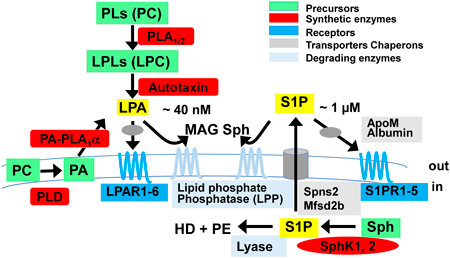- 著者
- Yugo Takagi Shun Nishikado Jumpei Omi Junken Aoki
- 出版者
- The Pharmaceutical Society of Japan
- 雑誌
- Biological and Pharmaceutical Bulletin (ISSN:09186158)
- 巻号頁・発行日
- vol.45, no.8, pp.1008-1021, 2022-08-01 (Released:2022-08-01)
- 参考文献数
- 145
- 被引用文献数
- 5
Lysophospholipids are phospholipids with only one fatty acid. During the past two decades, it has become apparent that lysophospholipids are not merely degradation products but have various physiological and pathological functions in vivo via G protein-coupled receptor (GPCR)-type receptors. These include lysophosphatidic acid (LPA), sphingosine 1-phosphate (S1P), lysophosphatidylinositol/lysophosphatidylglucose (LPI/LPtdGlc), and lysophosphatidylserine (LysoPS). This review focuses on identifying the functions of the receptors, enzymes, transporters, and carrier proteins required for these four lysophospholipids to function as lipid mediators. We also note that many of advances in this field have been made by Japanese pharmaceutical scientists.
- 著者
- Daisuke Saigusa Ritsumi Saito Komei Kawamoto Akira Uruno Kuniyuki Kano Shuichi Shimma Junken Aoki Masayuki Yamamoto Tadafumi Kawamoto
- 出版者
- The Mass Spectrometry Society of Japan
- 雑誌
- Mass Spectrometry (ISSN:2187137X)
- 巻号頁・発行日
- vol.12, no.1, pp.A0137, 2023-12-12 (Released:2023-12-12)
- 参考文献数
- 16
The matrix-assisted laser desorption/ionization mass spectrometry imaging (MALDI-MSI) technique was used to obtain the molecular images of cryosections without labeling. Although MALDI-MSI has been widely used to detect small molecules from biological tissues, issues remain due to the technical process of cryosectioning and limited mass spectrometry parameters. The use of a conductive adhesive film is a unique method to obtain high-quality sections from cutting tissue, such as bone, muscle, adipose tissue, and whole body of mice or fish, and we have reported the utilization of the film for MALDI-MSI in previous. However, some signal of the small molecules using the conductive adhesive films was still lower than on the indium tin oxide (ITO) glass slide. Here, the sample preparation and analytical conditions for MALDI-MSI using an advanced conductive adhesive film were optimized to obtain strong signals from whole mice heads. The effects of tissue thickness and laser ionization power on signal intensity were verified using MALDI-MSI. The phospholipid signal intensity was measured for samples with three tissue thicknesses (5, 10, and 20 μm); compared to the signals from the samples on the ITO glass slides, the signals with conductive adhesive films exhibited significantly higher intensities when a laser with a higher range of power was used to ionize the small molecules. Thus, the technique using the advanced conductive adhesive film showed an improvement in MALDI-MSI analysis.
